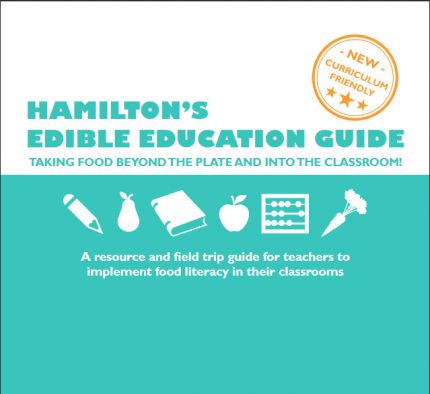Hamilton Edible Education Forum, Take Two
Posted: December 6, 2016
Categories: Edible Education Network / Food in the News / GoodFoodBites / Schools
By Cailey Campbell, Food Skills Program Coordinator at Neighbour to Neighbour’s Hamilton Community Food Centre (a partner of Community Food Centres Canada) in Hamilton, Ontario
Here in Hamilton there are lots of people doing Edible Education in schools, after-school programs and summer camps, in community gardens, and of course at home too. So when Neighbour to Neighbour co-hosted the first Hamilton Edible Education Forum in 2014 we got a snapshot of the many events, campaigns, and programs happening around food education for youth and children. From those first discussions, the Hamilton Edible Education Guide was born (led by Tastebuds Students Nutrition Collaborative) as a one-stop shop for food literacy programming for classrooms. 
This past October (2016), Neighbour to Neighbour helped to organize a second Edible Education Forum. The event brought together a dynamic group of people from across sectors, fueled by fair trade coffee and a good helping of freshly made tamales. We were able to re-open discussion on the Hamilton Edible Education Guide and explore what kind of networking could be possible. Essentially, the forum was a space for people involved in edible education to make connections, share ideas, and evaluate our current tools and frameworks.
Community members who participated in the discussion are people engaged with youth spaces from: school boards, small businesses, not for profits, and even a high school environmental club! With the goals of edible education written out in front of us, we took a look at the Hamilton Edible Education Guide. In groups we discussed what we liked about the guide, what was missing from it and how it could be changed. Just about all the groups in the room overflowed with ideas about ways to shift things around, change them up and re-frame the guide to take it to the next level. Among the many good ways to move forward with Hamilton’s Edible Education Guide, some suggestions and first steps are to:
- Expand the audience of the guide beyond the walls of the classroom (think: programmers in youth groups, after-school programs, rec programs, etc)
- Continue to expand the guide for teachers to include more curriculum links with numeracy, in-class activities and outside educators who can come into the classroom
- Help to promote the guide among youth groups so that they can advocate to their teachers as well
Emphasized throughout these discussions was the need for more encouragement of culturally-relevant food programming, food justice and racial justice advocacy. Another focus was the importance of involving communities in ways they feel are appropriate and comfortable. With so much going on, we learned that capacity was low amongst participants for establishing an official Network with regular meetings. Despite low capacity, many expressed that more work needed to be done on the level of advocacy for youth to have their voices heard. One idea is to host meetings that are also educational and where youth voices are included and amplified.
In the meantime, edible education is happening in Hamilton and the opportunity to meet up, make connections, and hear from each other at this year’s forum have been energizing and inspiring.
For more information or to ask for a copy of the full report please contact:
Cailey Campbell, Community Food Skills Program Coordinator, Neighbour 2 Neighbour’s Hamilton Community Food Centre, ccampbell@n2ncentre.com
